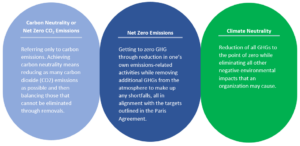Why do we need Net Zero?
Since the Industrial Revolution human activities, like burning fossil fuels such as oil and coal and deforestation, have led to an accumulation of greenhouse gases (GHGs) in the atmosphere, which is causing global temperatures to rise. Global average temperatures have increased by about 0.8°C to 1.2°C (1.4°F – 2.2°F) above pre-industrial levels, according to the Intergovernmental Panel on Climate Change.
We are already starting to feel the effects of a hotter planet — temperature extremes, droughts, heavy precipitation, more extreme weather events and rising sea levels. If business continues as usual, the temperature of the Earth’s surface is expected to rise to 2.5 – 5°C (4.5°F – 9°F) above pre-industrial levels by the end of the century. This will permanently damage ecosystems and biodiversity, while threatening human health, food sources, fresh water supply and economic growth.
To limit global average temperature growth to 1.5°C (2.7°F) by mid-century — a target set forth in the U.N.’s Paris Agreement to mitigate the effects of climate change — we need to cut carbon dioxide emissions in half by 2030 and reach “net-zero” CO2 emissions by 2050, while also minimizing other GHG emissions, according to the IPCC.
What is Net Zero?
Net zero is the state of reaching a global balance between human-caused greenhouse gas emissions and the human efforts to remove carbon from the atmosphere, while eliminating anthropogenic CO2 emissions entirely.
For businesses, net zero requires eliminating CO2 emissions from their activities, including throughout the entire value chain, while compensating for emissions that have yet to be eliminated using decarbonization and removal efforts. Scientists recognize that carbon removal processes and decarbonization technologies are neither sufficient nor scalable enough to offset emissions by themselves. So, net zero is a significant commitment to reducing emissions by 90% or more. The goal is to remove nearly all GHG emissions from corporate processes by 2050, while neutralizing any remaining emissions with carbon removal efforts.
How can businesses achieve Net Zero?
Through the U.N. Race to Zero campaign, 22 regions, 452 cities, 1,101 businesses, 549 universities and 45 investors have committed to net zero as of September 2020, according to the U.N. Framework Convention on Climate Change. But setting your company on the path to net zero requires more than signing an open letter. Companies need ambitious emissions targets with evidence-based plans on how to reach their goals.
To achieve net zero, businesses need to first assess the entire value chain and identify sources of GHG emissions. With a full picture of their climate footprint, businesses can develop science-based targets to eliminate emissions on a timeline that aligns with global goals. Then it’s time to connect the dots. Companies will need to model alternatives and craft a plan to reach net-zero targets over time. Lastly, businesses must also consider compensation efforts for any emissions that can’t be removed for technical or economic reasons, by either removing carbon from the atmosphere through sequestration or afforestation or reducing emissions beyond the immediate value chain.
Net Zero vs. Carbon Neutrality vs. Climate Neutrality
Many businesses may use the terms “net zero,” “carbon neutral” and “climate neutral” interchangeably, but it’s important to understand the nuanced differences to set clear, actionable goals. Generally each of these terms is used to talk about neutralizing the impact of a business’ emissions on the environment.
Carbon neutrality may refer to zeroing out CO2 emissions through reduction and removal. Net zero goes beyond CO2 and encompasses all GHG emissions. Climate neutrality, on the other hand, considers all human impacts that affect the climate.

Source: IPCC. For detailed definitions see their Glossary of Terms.
When Sphera’s Sustainability Experts assist a company in assessing its carbon footprint, we always include all GHGs, which are then converted into CO2 equivalents in line with all relevant standards. That’s why when we hear carbon neutrality and net zero being used as synonyms, we prefer to use net zero to avoid confusion.





